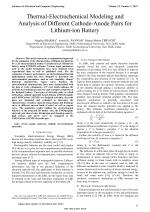| 3/2021 - 7 |
Thermal-Electrochemical Modeling and Analysis of Different Cathode-Anode pairs for Lithium-ion BatterySHARMA, S. |
| Extra paper information in |
| Click to see author's profile in |
| Download PDF |
Author keywords
anode, batteries, cathode, electrochemical, electrodes
References keywords
lithium(36), electrochemical(25), battery(23), batteries(21), thermal(19), power(14), sources(13), model(13), energy(13), jjpowsour(10)
Blue keywords are present in both the references section and the paper title.
About this article
Date of Publication: 2021-08-31
Volume 21, Issue 3, Year 2021, On page(s): 57 - 64
ISSN: 1582-7445, e-ISSN: 1844-7600
Digital Object Identifier: 10.4316/AECE.2021.03007
Web of Science Accession Number: 000691632000007
SCOPUS ID: 85115236923
Abstract
This article represents a computational approach for the estimation of the characteristics of lithium-ion batteries for a 2D electrochemical model of cylindrical type lithium-ion battery using COMSOL software. Various input parameters used in the model formulation have been obtained from experimental data as well as published work. For the evaluation of battery performance, an electrochemical-thermal mathematical model has been designed to determine the electrochemical parameters such as rate capability, charge/discharge characteristic, ragone curve. Further, the electrochemical characteristics have been characterized with the help of cyclic voltammetry (CV) test which indicates the uniform electrochemical reactivity and transport properties of the designed battery. Two types of electrode pairs in which LiMn2O4 as cathode materials form LiMn2O4 (LMO)/Graphite and LMO/Carbon (MCMB) are designed and these electrode pairs are simulated and evaluated to determine the characteristics of battery material using charge and discharge curve at different current loads (C-rates) as well as ragone curve. The simulation results validate the electrochemical behavior of the proposed 2D model. Also, the LMO/graphite electrode pair shows better discharging and charging capacity, high energy, and power curve as compared to the LMO/Carbon (MCMB) electrode pair. |
| References | | | Cited By |
Web of Science® Times Cited: 1 [View]
View record in Web of Science® [View]
View Related Records® [View]
Updated 3 weeks, 6 days ago
SCOPUS® Times Cited: 2
View record in SCOPUS® [Free preview]
View citations in SCOPUS® [Free preview]
[1] Multiscale Modeling and Experimental Characterization for Enhancement in Electrical, Mechanical, and Thermal Performances of Lithium-Ion Battery, Sharma, Snigdha, Panwar, Amrish K., Tripathi, M. M., Frontiers in Energy Research, ISSN 2296-598X, Issue , 2022.
Digital Object Identifier: 10.3389/fenrg.2022.851377 [CrossRef]
[2] Comparative Study of NCM and NCA Electrode Material for Capacity-Fade Using 1-D Modeling, Gupta, Ebani, Verma, Vikas, Khulway, Gaurav, Panwar, Amrish K., International Journal of Electrical and Electronics Research, ISSN 2347-470X, Issue 3, Volume 10, 2022.
Digital Object Identifier: 10.37391/ijeer.100308 [CrossRef]
Disclaimer: All information displayed above was retrieved by using remote connections to respective databases. For the best user experience, we update all data by using background processes, and use caches in order to reduce the load on the servers we retrieve the information from. As we have no control on the availability of the database servers and sometimes the Internet connectivity may be affected, we do not guarantee the information is correct or complete. For the most accurate data, please always consult the database sites directly. Some external links require authentication or an institutional subscription.
Web of Science® is a registered trademark of Clarivate Analytics, Scopus® is a registered trademark of Elsevier B.V., other product names, company names, brand names, trademarks and logos are the property of their respective owners.
Faculty of Electrical Engineering and Computer Science
Stefan cel Mare University of Suceava, Romania
All rights reserved: Advances in Electrical and Computer Engineering is a registered trademark of the Stefan cel Mare University of Suceava. No part of this publication may be reproduced, stored in a retrieval system, photocopied, recorded or archived, without the written permission from the Editor. When authors submit their papers for publication, they agree that the copyright for their article be transferred to the Faculty of Electrical Engineering and Computer Science, Stefan cel Mare University of Suceava, Romania, if and only if the articles are accepted for publication. The copyright covers the exclusive rights to reproduce and distribute the article, including reprints and translations.
Permission for other use: The copyright owner's consent does not extend to copying for general distribution, for promotion, for creating new works, or for resale. Specific written permission must be obtained from the Editor for such copying. Direct linking to files hosted on this website is strictly prohibited.
Disclaimer: Whilst every effort is made by the publishers and editorial board to see that no inaccurate or misleading data, opinions or statements appear in this journal, they wish to make it clear that all information and opinions formulated in the articles, as well as linguistic accuracy, are the sole responsibility of the author.



